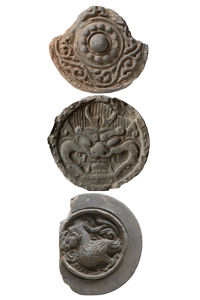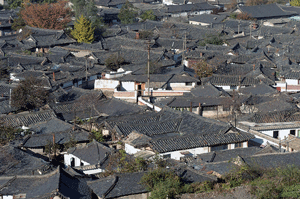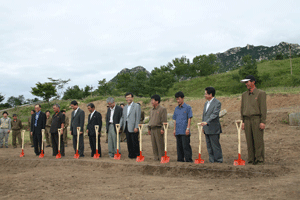
A joint project between the two Koreas searches for their shared history

Archaeologists are working to uncover the huge 10th-century Goryeo Dynasty palace complex of Manwoldae at the base of Mount Songak in North Korea.
(National Research Institute of Cultural Heritage)
At the foot of Mount Songak, in the center of the Korean peninsula, sits Manwoldae, a vast tenth-century royal palace complex built by the Goryeo, one of medieval Korea's least-known dynasties. There is an ancient explanation for this gap in knowledge about medieval Korean history: Although the Goryeo ruled for almost 400 years, they left very few records of their own, and the sparse texts in which they are mentioned were written by historians from the succeeding Joseon Dynasty. There is also a modern reason why we know so little. Most Goryeo sites, including Manwoldae, are located in North Korea, which is almost entirely closed to foreign researchers.
However, for the past three years, in an unusual collaborative effort, North and South Korean archaeologists have been coming to Manwoldae to explore the palace's unique architectural and engineering achievements, which reveal a profound respect for the natural landscape. The subtext to all of this is that even as the two modern nations are divided by politics and geography, they are there to uncover evidence of their shared history through the story of the Goryeo Dynasty—one of the first to unite ancient Korea.
In 2005, scholars from the two Koreas held a joint conference in Kaesong, North Korea, only 45 miles from the South Korean capital of Seoul, and site of the Goryeo Dynasty's main capital, Gaegyeong. At the meeting, cohosted by the Inter-Korean Historian Conference and the North's People's Reconciliation Council, South Korean scholars proposed that the two nations conduct a joint excavation in the Kaesong Historical District, a large area encompassing all the city's historic sites, including Manwoldae, the tombs of the Goryeo kings, and Sungkyunkwan, a former Confucian educational institute, among other sites.

Among the artifacts they have recovered are more than a thousand patterned ceramic roof tiles decorated with vines and dragons.
(National Research Institute of Cultural Heritage)
"At first the North Korean scholars found the suggestion absurd," says Seo Joong-seok, a professor of Korean history at today's Sungkyunkwan University in Seoul. "This was understandable, because the project would take at least two months, and even in Pyongyang, which is the city in North Korea most open to foreigners, South Koreans aren't allowed to stay longer than two weeks." Nonetheless, in January 2006, an agreement was signed to conduct an excavation at one historic site. Because the North Koreans had been working for at least seven years to register the Kaesong Historical District on UNESCO's World Heritage List, they proposed Manwoldae as the site for the project.
The North Korean leadership places a great deal of emphasis on its country's history. Kim Il-sung (1912–1994), the founder of the Democratic People's Republic of Korea, was particularly proud of the Goguryeo Kingdom, which preceded the Goryeo Dynasty. The Goguryeo, known for their military prowess and brave spirit, covered a massive territory that included not only today's North Korea, but southern Manchuria and southeastern Russia as well. Kim said, "The era in which our country was the strongest in our history was the Goguryeo era," and he highlighted the need to learn about and preserve the country's history in order to spread his own form of strongly branded nationalism.
Historians in both North and South Korea generally agree that the Goryeo sought to emulate the spirit of the Goguryeo and to be their successors. They say that Taejo, the dynasty's founder (A.D. 877–943), named it "Goryeo" for its similarity to "Goguryeo" and kept the previous kingdom's capital, Seogyeong (today's Pyongyang), as his secondary capital. Scholars also believe Taejo was in a constant struggle to recover the former territory of the Goguryeo, which had been lost to the Silla Dynasty in A.D. 668.
The South Koreans saw the project as an opportunity to promote cultural exchange and build better relations between the two Koreas. Like the North Koreans, they also embraced the goal of preserving the country's history. Manwoldae is equally important to both nations as evidence of their past. The South Koreans would also be able to share new archaeological technologies and equipment that had previously been unavailable to the North Koreans due to the country's economic difficulties.

Manwoldae is located next to the modern city of Kaesong, the ancient Goryeo Dynasty capital of Gaegyeong. In an effort to conserve not only the palace complex but the area around it, the North Korean government has designated these traditional hanok houses for historic preservation.
(National Research Institute of Cultural Heritage)
The project was set to begin on July 3, 2006. But on June 30, the North Korean archaeologists sent a fax saying that the excavation had to be postponed. In October 2006, the North conducted a nuclear test that soured inter-Korean relations, and it wasn't until April 2007 that Korean officials from both sides reaffirmed their promise to jointly excavate Manwoldae. Finally, that May, 11 South Korean archaeologists traveled through the Demilitarized Zone by bus and met their colleagues in Kaesong.
Today Kaesong, located at the center of the Korean peninsula and known for its high-quality ginseng, is a large city with a population of about 380,000. But Kaesong's heydey was in the years between A.D. 919 and 1392, after Taejo declared that Gaegyeong would be his new capital. He immediately began to build Manwoldae, a name given to the palace by the Joseon Dynasty. (It is thought that the Goryeo called it either "the imperial palace" or "the forbidden inside.") The entire complex is believed to have covered more than six acres and contained more than 100 structures including living quarters, shrines, temples, a throne hall, a library, a treasure house, and an astronomical observatory. This would serve as the main palace for the duration of the Goryeo Dynasty, with the exception of the period from 1232 to 1271 when the capital was moved temporarily to the island of Ganghwa on the west coast of Korea, 36 miles from Seoul, during the Mongol invasion.
To help choose the site, Taejo's father, Wang Ryung, met with the Buddhist master Doseon, whose theories on geomancy—a type of divination using figures, lines, or geographic features—would greatly affect the Goryeo Dynasty. Finally Taejo settled on the site at the base of Mount Songak, which Koreans say is shaped like a pregnant woman lying down with her hair pulled back and her hands on her chest. There were also other, more practical reasons Taejo settled on the site. The Goryeo Dynasty was established on the Korean peninsula after 50 years of internal conflict among different regional forces. Thus, security was a top priority. Taejo located the palace in a basin surrounded by high mountains over which his enemies could not pass, adding additional protection with a complex ringed system of fortresses, some of which are still visible, along the mountains' ridges. The outermost of these fortresses lay 14 miles from the palace itself and had no less than 25 gates, a large number that indicates the sophistication and engineering of Goryeo architecture. (One of the largest fortresses of the subsequent Joseon Dynasty had only eight gates.)

At the opening ceremony of the excavations at Manwoldae in 2007, North and South Korean archaeologists celebrate this historic joint archaeological project.
(National Research Institute of Cultural Heritage)

One of the main distinguishing features of Manwoldae is the complicated set of drainage canals, part of which is being excavated (right). The drainage system is one of several examples of the sophisticated engineering skills the Goryeo used in constructing the palace.
(National Research Institute of Cultural Heritage)
With Mount Songak as its backdrop, records show the palace was not only imposing, but beautiful. Seogeung, an envoy from China's Song Dynasty (A.D. 960–1279), visited the Goryeo capital in 1123 and wrote a book called Goryeo Pictures and Texts based on what he saw on his trip. "The ridges of the roofs are connected as if flying through the air and decorated with dancheong [traditional multicolored paint on wooden buildings] of red and blue." He also would have seen pillars, staircases, and roof tiles covered in elaborate decorative patterns such as phoenixes, dragons, and devils' masks, as well as chrysanthemums, peonies, and creeping vines.
When North Korean archaeologists first came to Manwoldae in 1954, they could not see the glorious palace that Seogeung had described. In 1361 the palace was burned down by the Red Turban Army, soldiers of China's Yuan Dynasty. In fact, very little of the wooden palace remained and only the stone foundations survived intact. During these first excavations at the site, the North Koreans worked in an area of the palace called the hoegyeongjeon (throne hall), thought to have been built in the early eleventh century. Unfortunately, according to Park Sung-jin, a researcher at the National Research Institute of Cultural Heritage who has participated in the joint project since 2007, very few excavation reports from this dig exist. Today, four huge stone staircases that once led to the throne hall are all that can be seen from these excavations. The next campaign took place in the early 1970s, during which time archaeologists continued their work in the hoegyeongjeon. In 1994, digging began in the wondeokjeon, where military meetings are thought to have taken place. At the Goryeo Museum in Kaesong, which opened in 1988, more than 1,000 artifacts from the dynasty are on display, including armor, weaponry, ink sticks, ink stones, silk, beads, and pottery uncovered during these earlier excavations.
Since 2007, four seasons of the joint North-South archaeological project have taken place. Lee Sang-jun, a researcher at the National Institute of Cultural Heritage, directed the South Korean archaeologists at the site. The North Korean archaeologists came from the Chosun Central History Museum in the capital of Pyongyang. "The moment I arrived at the site, I knew that it would be an excavation that would not be easy, but at the same time could lead to some groundbreaking discoveries," says Lee. The first round of excavations consisted of trial trenches in sections of the area west of the hoegyeongjeon. In that first year, the team uncovered stonework covered in decorations depicting kudzu vine, stone foundations of varying sizes on manually leveled ground belonging to seven or eight buildings, and countless pieces of decorated roof tiles. Overall, more than 7,500 artifacts were uncovered.

The Goryeo were famous for their celadon, a type of pottery which uses a distinctive green glaze. This 2-foot-tall vase is one of the largest celadon pieces ever found in Korea.
(National Research Institute of Cultural Heritage)
Between September 2007 and March 2010, scholars began to get a picture of many of Manwoldae's structures and their arrangement. These had been largely unknown with the exception of the area around and including the hoegyeongjeon. In 2010, more than 40 buildings were identified and then grouped together in zones that appeared to contain buildings with similar functions. Zone A, which was excavated by Lee's team, had seven large buildings and encompassed the king's living quarters, audience chamber, library, and bedrooms. Zone B was crowded with smaller structures that are thought to have had ritual purposes.
In Zone C, archaeologists uncovered one of the excavation's highlights, the tenth-century gyeongnyeonjeon, a building where officials kept the portraits of Taejo and other former kings, and where they performed ancestral rituals attended by the king himself. When they came upon stone foundations that had supported five parallel rooms, they identified it using historical records that say "there was a fire at the gyeongnyeonjeon, and Eunggyu [a government official] ran inside and got the portraits of former kings kept in five rooms." Archaeologists have never been able to excavate a gyeongnyeonjeon at any other Korean palace.
Kim Dong-uk, a professor of architectural history at Kyonggi University who took part in the excavation, says that the Goryeo palace is unique in many ways. "The site poses several disadvantages as it's hilly and heavy rains could make the buildings collapse, but the Goryeo sought to overcome that by ingenious architectural techniques," he says. Unique among them, according to Ryu Chung-seong, a researcher at the Chosun Central History Museum, was a sophisticated system of drainage canals that encircled almost all the structures in the palace complex and was constructed like a net. "This was done in a careful, scientific, and calculated manner," he says.
But scientific principles were not the only guiding force the Goryeo used in building Manwoldae. They did not want to change the landscape or destroy the topography, unlike many other Korean palaces before and after, as well as contemporary palaces in neighboring countries such as China and Japan. Hence, Manwoldae's main axis is not strictly vertical, nor are its structures symmetrically positioned. Rather, it respects the natural landscape. "Even the roads and drainage canals are designed to be organically connected. I call this type of architecture 'nature-adapting' and 'environment-respecting' architecture," says Kim. "Building a palace on a hilly site with this elaborate architectural system also had the added advantage of making it look more imposing than it actually is," he adds.

The distinctive alignment of five parallel rooms allowed archaeologists at Manwoldae to identify this structure as a gyeongnyeonjeon, a building where portraits of the Goryeo Dynasty kings were kept.
(National Research Institute of Cultural Heritage)

A replica of Manwoldae at the Goryeo Museum in Kaesong shows the palace's large scale, impressive appearance, and picturesque location at the base of the mountain.
(National Research Institute of Cultural Heritage)
The finds at Manwoldae are not limited to architectural and engineering achievements. One of the most surprising artifacts uncovered in 2007 is a well-preserved, two-foot-tall celadon cylinder. Celadon is a type of ceramic ware invented in China whose distinct characteristic is its pale, jade-green glaze. The cylinder has large holes on the top and bottom and features delicate and complex inscribed patterns of grapevines and peonies on its surface. Goryeo celadon is famous for its high quality and is found at almost all Goryeo sites, including kings' tombs and a fourteenth-century ship discovered off Korea's southeastern coast. Yun Do-hyeon, a celadon artisan who currently works in South Korea, greatly admires the ancient artist's work. "A celadon piece as large as this is rarely made, as there are risks of bending and even damaging the work," Yun says. Even when much smaller celadon pieces are placed in a furnace to be fired, the inconsistent heat results in only one in five objects emerging undamaged. Archaeologists are still unsure of the cylinder's function since nothing like it has ever been found in either North or South Korea. Some scholars speculate that it might have had a somewhat mundane purpose, such as holding a plant, while others say it was likely used for some sort of royal ritual.
Several other important celadon artifacts were among the 1,400 pieces of pottery uncovered during the joint excavation. Hundreds of roof tiles confirm historical records that in 1157, a large pond and a pavilion for the king's entertainment had been built within the palace compound. Its roof had been covered with this kind of tile. Archaeologists also discovered the base of a thirteenth- or fourteenth-century masangbae, a celadon cup specifically intended for drinking while horseback riding. During the Goryeo Dynasty, it was the custom for the king to bestow a drink on a commander going to war in order to wish him victory, and it is possible that this masangbae is an example of this type of cup.
Another major find was a roof tile inscribed in Sanskrit, one of 114 roof tiles with text that were recovered in the excavation of Manwoldae. The tile contains the word Amit?bha, which roughly translates as "The Buddha of Infinite Light," leading archaeologists to suggest that it had been used in a religious structure. While the Goryeo Dynasty was influenced by both Confucianism, which came to Korea from China during the Three Kingdoms Period (57 B.C.–A.D. 668), and Daoism, which arrived in the seventh century A.D., it was most notably influenced by Buddhism. Goryeo rulers built Buddhist temples, supported Buddhist monks, and created some of the world's most precious Buddhist art, including paintings and scriptures housed in pagodas and temples all across both North and South Korea.
According to Lee Sang-jun, so far only about one-fifth of Manwoldae has been excavated. In order to truly understand the site's complexity and the Goryeo Dynasty's ingenuity, he estimates that the project will take at least another 30 years. Researchers from the North also agree that the work at Manwoldae must be a long-term project, but thus far have signed on to work as part of the cooperative effort only until 2012. The sobering truth is that with inter-Korean relations currently at one of the lowest points in recent memory, it is impossible to know how long the North and South Koreans' cooperative effort to uncover their past will continue.
Hyung-eun Kim is a reporter at Korea JoongAng Daily, a Seoul-based English-language newspaper.
Advertisement

Advertisement







